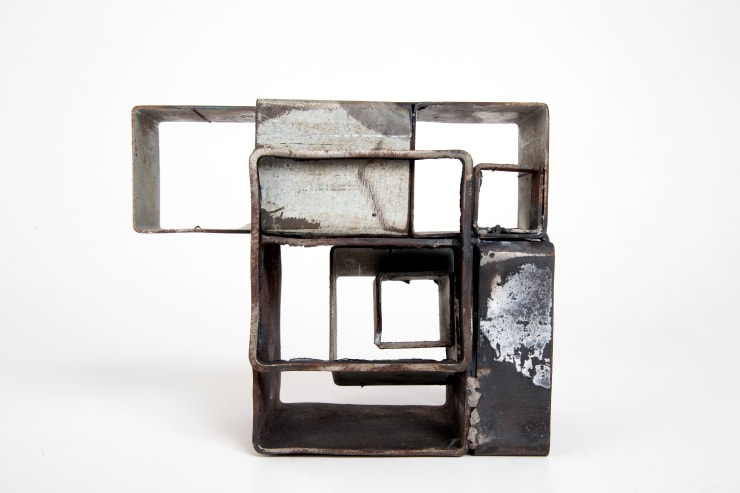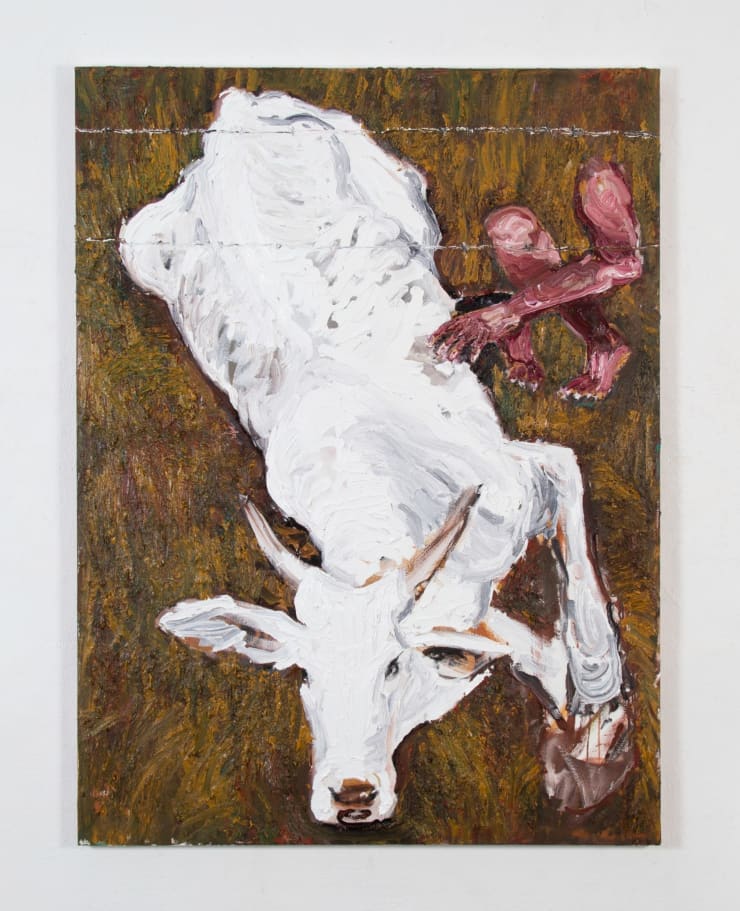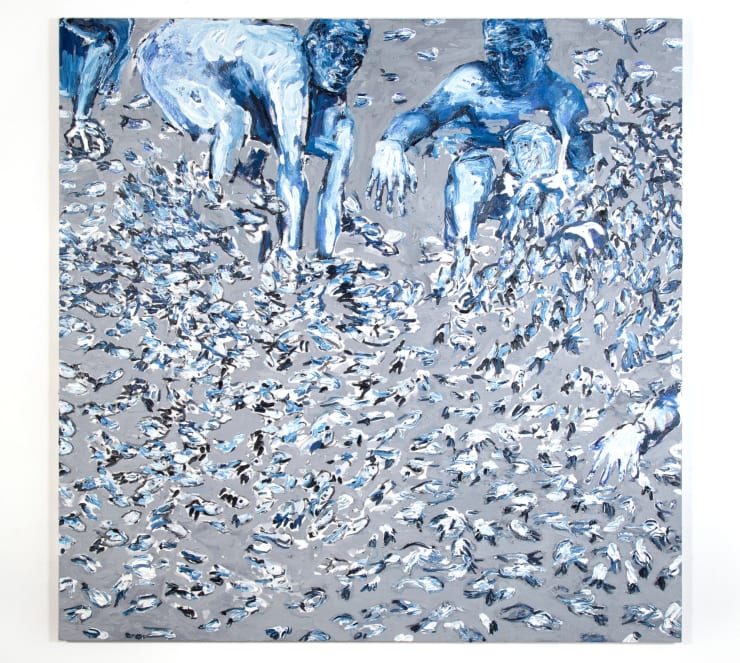-
A Gentil Carioca is pleased to invite all to the first individual exhibitions of Agrade Camíz, Cibelle Arcanjo, Herbert de Paz and
Vinicius Gerheim, four young artists who use painting as a support to approach their origins and identities.
-
Agrade Camíz | Abusada
-
-
Agrade Camiz: your name is on judas or from suburban to suburban
The suburbs are hell, gossip, name on Judas, cable robbery, kite wax in the eyes, teasing, bullying.
- Camila, look at this outfit, this hair, this ass!
Where is self-love? Own home? Own car? Own life?
Packed bus. Packed train. Packed BRT. To the parties, men bring drinks and women bring food. Where are the art movies? Where are the art exhibitions? In the malaise, pray for the shingles, fig blessing for the pillow, dream of good luck. What the hell happened to you?It's all written on the walls. And the streets, full of leisure and bougainvilles.
The suburb raises itself; the single mother asks for help from the neighbor, the child takes the groceries of the elders, the teenagers help to push the broken car. If the roof breaks, a joint effort to place the slabs. If the daughter makes her debut, a party room for binary waltzes, man with woman, woman with man. What the hell!
But what does it matter for Agrade Camíz to spring up in the suburbs and keep up appearances? No, Camíz's paintings cross the hypocrisy of the facts, denounce child abuse, bring warning signs, make it explicit. In everything, you can see the suburbs. Dissatisfied, she can tag in the streets.... I will “firm my footing in otherness”, “mark my territory”. From the houses in the housing complexes, Agrade paints the portraits of veiled abuses: the disrespected and defied child. Whose fault is it? Dick Aquaplay. Scream to whom?
Let go of your own body, let go of your body and speak. Make a body of the painting, tattoo and inscription from ink. Writing or painting, whatever. "But a little too late." “After all, a little of each”. Make eye-catching paintings. E-y-e-c-a-t-c-h-i-n-g. Smudge, stain, drain, become intelligible, fuck the conceptual. "In this house, live other intentions or intensities".
Observing the construction of Agrade Camíz is realizing the need to cross the walls of love and denunciation, subjectivity and memory. Leave behind an idyllic and bucolic suburb that never existed. Reach other city gates, other railings. But arrive making a scene, frustrating the expectations of those who wait for the colors and write so that they can dream of self-love, as luck, pray, ribbon of faith on the wrist. “Fed up with the world”.
Marcelo Campos
-
-
Cibelle Arcanjo | Muvucas
-
-
Muvucas
Evocation, the series by the artist Cibelle Arcanjo, is about a swarm of seeds that become a forest. Muvuca, an indigenous technology for planting native species with fast, medium, and long growth, is carried out in view of the plurality of plants, interspecific associations, and the exercise of intermediate and mediation states. In the wisdom of muvuca, it is necessary to recognize the sharing of nutrients between different species, as well as the roles of the death and life cycles of medium and fast-growing plants in protecting the soil and stimulating long cycle plants.
Like the muvuca, the intermediate states and harmonic associations “between-beings” are present in Cibelle's production. In the works Sopro (Blow), Guardião (Guardian) and Roda, gira, círculo, volta (Wheel, spin, circle, round), the body is the connection with roots, leaves, living beings, entities, orishas, air, water, fire, stars, and planets. Such elements can be understood as “what is around” or “the environment”, but I prefer to call them, provoked by the images, as “what goes through” and is “inseparable from being”.
The cycles of life and death of plants, in collaboration, lead to the notion of death in the Judeo-Christian tradition. Death well lived can generate life, become creation. Epá Babá! In Criação (Creation), Cibelle sharpens her income by becoming a lacemaker. On the canvas, the lace merges with the architecture of the hills, the beads come to life and the image receives a celestial luminosity. On the other hand, in the works Dar corpos às nossas lágrimas, deixar fluir o nosso sangue (Give body to our tears, allow our blood to flow), and Colheita na Floresta (Harvesting in the forest), the artist refuses the obliteration of colonial ecocides, genocides and epistemicides. In Harvesting in the forest, the bullet disguised as a seed reminds us of the false promises of the development of agribusiness.
Against the grain of the mono cultures, the works Busca em sussurros (Searching in whispers),Sinergia (Sinergy) e Cruzeiro do Sul (Southern Cross), bring lessons of seeing in the dark and learning in silence and doubt. With the management of digital color saturation in paintings, Cibelle evokes the biological mechanism of adaptation of retinas to light. Thus, she invites us to sensitize our eyes; namely to confuse beads with seeds.
By Joyce Delfim1
1 Researcher, curator and art educator. MA in Advanced Studies in Art History from the University of Salamanca and PhD student in Visual Arts from the Federal University of Bahia.
-
-
Herbert De Paz | Ibirapema
-
-
Ibirapema: ‘esto de pelear con los cristianos no es como comer tortillas’1
More and more, the way in which canons are operated in the field of art history, seek possibilities for the (re) elaboration of pasts, through a critical position in the traditional regime of the circulation of images. In the research of the Salvadoran artist Herbert De Paz, the colonial processes of artistic and cultural interpretation are dissolved in the study of the rudiments of a Euro-Christian episteme. His paintings reveal insurgent silhouettes, depicting a complex area of discursive dispute against socially geared ways of seeing and inhabiting the world.
Images of Rugendas, Sá, and Bry are disordered along with the Cucumbis who dance through the streets of Rio de Janeiro in the 18th century, an ode to non-standardized bodies that escape subjugation, through dance as an engine of freedom and insurrection. They also allude to a popular manifestation in the Americas, ordered by the representation of the conflicts of religious conversion between Moors and Christians, the dance of historians, a dance that was perpetuated by missionaries in the Americas, contributing to the imposition of Christianity as the only path short of annihilation.
Leda Maria Martins, in this sense, proposes the understanding of the body as a portal of wisdom, where, through corporeal performance, time is crossed, therefore, thinking about history beyond coloniality requires attention to transtemporal vehicles for maintaining life. In these works, we see overflows between evangelization and dance, worked from episodes where the Americas, and the bodies that inhabited these lands, assert themselves as the pulsating movement of a dance amid war. If the colonization undertaken by the State and the Clergy elaborated complex strategies of domination, Ibirapema, metamorphosed like a brush, interrupts the continuity of the catechization of our imaginaries. In this regard, Herbert De Paz understands pictorial language as one of the possible axes of prefiguration of the world, affirming aesthetic proposals in opposition to images guided by interpretive methods and founded on traumatic and violent spectres.
Aldones Nino
1 Excerpt taken from La Historiade Carlos Magno, according to oral transmission, from the article by Salvadoran philosopher Reynaldo Antonio Rivas: Los historiantes de Huertas: La danza de los Moros y Cristianos (2021), in Revista de Museologia Kóot, year 11, no. 12, p.71-87.
2 MARTINS, Leda. Performances da oralitura: corpo, lugar da memória. In: Língua e Literatura: Limites e Fronteiras. Revista do Programa de Pós-graduação em Letras, n. 26 (Jun. 2003), p.75.
3 IIbira-pema, ivirapema, ivirapeme, tacape or tangapema was the wooden club with which the Tupi, who inhabited most of the Brazilian coast in the 16th century, killed their prisoners of war.
4 Art Historian, Training and Education Advisor at the Instituto Inclusartiz (Rio de Janeiro, Brazil) and Adjunct Curator of Collegium (Arévalo, Spain).
-
-
Vinicius Gerheim | Primeiras Estórias
-
-
The temporal phenomena between the large gap in living and dying are actions of our senses, of the sensations that embody the cycles, of the emotions that drive the perceptions and experiences that shape our existence. In Primeiras Estórias, a series of paintings by Vinícius Gerheim, the spontaneous relations among various kinds of sensations connected by actions of memory, intuition and imagination of the artist are highlighted. The childhoood in the mountains of Minas Gerais, smothered by the atmosphere of extractivism and forgiveness, is designed to refute the fragmentation of life projects carried out by the heteronormative cistem of institutionalities. Eyes that feed and watch over, some bleed before starting to play, others already protect biting. Shapes, rhythms, vibrations, and sympathies compose relations of forces that encrypt their own existence. These are paintings that disrupt the boundaries of the public and private by managing the limits of language andof the self. I feel, as I witness Vinicius' canvases, which are traversed by inked gestures, a call to a deep imbrication with the cycles of life, symbiotic, affected by the constant interconnections that we can feel when we are willing. The end is intensified, the limits are widened, one digs a little more, when one is aware of the purpose of beings and things, living the intervals with greater passion.
Walla Capelobo11 Afrotransfeminist and anti-colonial researcher and artist. Graduated in History of Art (EBA/UFRJ) and MA student at PPGCA (IACS/UFF). Collaborator in desculonizacion and CIPEI (Mexico - Brazil).
-
-
-

Agrade Camíz
-

Cibelle Arcanjo
-

Herbert De Paz
-

Vinicius Gerheim
-
Agrade Camíz | Cibelle Arcanjo | Herbert De Paz | Vinicius Gerheim
Past viewing_room







![Agrade Camíz, Sem título [Untitled], 2021](https://artlogic-res.cloudinary.com/w_740,c_limit,f_auto,fl_lossy,q_auto/artlogicstorage/agentilcarioca/images/view/fa7cbab17e0668aabac05a1b9cf0b75cj/agentilcarioca-agrade-cam-z-sem-t-tulo-untitled-2021.jpg)























![Cibelle Arcanjo, Cruzeiro do Sul [Southern Cross], 2021](https://artlogic-res.cloudinary.com/w_740,c_limit,f_auto,fl_lossy,q_auto/artlogicstorage/agentilcarioca/images/view/3f7043b1a73ee75bd81cb4cc29847561j/agentilcarioca-cibelle-arcanjo-cruzeiro-do-sul-southern-cross-2021.jpg)
![Cibelle Arcanjo, Sopro [Blow], 2021](https://artlogic-res.cloudinary.com/w_740,c_limit,f_auto,fl_lossy,q_auto/artlogicstorage/agentilcarioca/images/view/f604ea9cf3af93fa83c5d341043c3f49j/agentilcarioca-cibelle-arcanjo-sopro-blow-2021.jpg)
![Cibelle Arcanjo, Dar Corpo às nossas lágrimas, deixar fluir o nosso sangue [Give body to our tears, allow our blood to flow], 2021](https://artlogic-res.cloudinary.com/w_740,c_limit,f_auto,fl_lossy,q_auto/artlogicstorage/agentilcarioca/images/view/d72e53a1cad36c62982c492fe55848b9j/agentilcarioca-cibelle-arcanjo-dar-corpo-s-nossas-l-grimas-deixar-fluir-o-nosso-sangue-give-body-to-our-tears-allow-our-blood-to-flow-2021.jpg)
![Cibelle Arcanjo, Colheita na floresta [Harvesting in the forest], 2021](https://artlogic-res.cloudinary.com/w_740,c_limit,f_auto,fl_lossy,q_auto/artlogicstorage/agentilcarioca/images/view/899cfc66ecc511857ea8df7717c2775fj/agentilcarioca-cibelle-arcanjo-colheita-na-floresta-harvesting-in-the-forest-2021.jpg)
![Cibelle Arcanjo, Guardião [Guardian], 2021](https://artlogic-res.cloudinary.com/w_740,c_limit,f_auto,fl_lossy,q_auto/artlogicstorage/agentilcarioca/images/view/5da46227b96bac024ce44ef8a718f058j/agentilcarioca-cibelle-arcanjo-guardi-o-guardian-2021.jpg)
![Cibelle Arcanjo, Busca em sussurros [Searching in whispers], 2021](https://artlogic-res.cloudinary.com/w_740,c_limit,f_auto,fl_lossy,q_auto/artlogicstorage/agentilcarioca/images/view/31cd96afb52ed0fee43ba870ed987176j/agentilcarioca-cibelle-arcanjo-busca-em-sussurros-searching-in-whispers-2021.jpg)
![Cibelle Arcanjo, Roda, gira, círculo, volta [Wheel, spin, circle, round], 2021](https://artlogic-res.cloudinary.com/w_740,c_limit,f_auto,fl_lossy,q_auto/artlogicstorage/agentilcarioca/images/view/a16ab66c3cbf61e273011a786e52ef1ej/agentilcarioca-cibelle-arcanjo-roda-gira-c-rculo-volta-wheel-spin-circle-round-2021.jpg)
![Cibelle Arcanjo, Sinergia [Sinergy], 2021](https://artlogic-res.cloudinary.com/w_740,c_limit,f_auto,fl_lossy,q_auto/artlogicstorage/agentilcarioca/images/view/9b96ffa7af619d60c0b896c052d27c0bj/agentilcarioca-cibelle-arcanjo-sinergia-sinergy-2021.jpg)
![Cibelle Arcanjo, Criação [Creation], 2021](https://artlogic-res.cloudinary.com/w_740,c_limit,f_auto,fl_lossy,q_auto/artlogicstorage/agentilcarioca/images/view/7058a48908a3e1e8fec5ea89a7587eebj/agentilcarioca-cibelle-arcanjo-cria-o-creation-2021.jpg)





![Herbert De Paz, A invenção da América [The Invention of America], 2021](https://artlogic-res.cloudinary.com/w_740,c_limit,f_auto,fl_lossy,q_auto/artlogicstorage/agentilcarioca/images/view/86c8e4f8f297bbd9c255c5a0cedb6946j/agentilcarioca-herbert-de-paz-a-inven-o-da-am-rica-the-invention-of-america-2021.jpg)
![Herbert De Paz, Herança [Heritage], 2021](https://artlogic-res.cloudinary.com/w_740,c_limit,f_auto,fl_lossy,q_auto/artlogicstorage/agentilcarioca/images/view/43a17f4773cb4ec97df9a4ed31683306j/agentilcarioca-herbert-de-paz-heran-a-heritage-2021.jpg)
![Herbert De Paz, Encontro II [Encounter II], 2021](https://artlogic-res.cloudinary.com/w_740,c_limit,f_auto,fl_lossy,q_auto/artlogicstorage/agentilcarioca/images/view/d6490369d30695ddb85ad242c3f404b9j/agentilcarioca-herbert-de-paz-encontro-ii-encounter-ii-2021.jpg)
![Herbert De Paz, Levante em Saint-Domingue (Revolução Haitiana) [Saint-Dominique Uprising (Haitian Revolution)], 2021](https://artlogic-res.cloudinary.com/w_740,c_limit,f_auto,fl_lossy,q_auto/artlogicstorage/agentilcarioca/images/view/7ba9d3050736348dbce83909c83bd05aj/agentilcarioca-herbert-de-paz-levante-em-saint-domingue-revolu-o-haitiana-saint-dominique-uprising-haitian-revolution-2021.jpg)
![Herbert De Paz, Avistamento [Sighting], 2021](https://artlogic-res.cloudinary.com/w_740,c_limit,f_auto,fl_lossy,q_auto/artlogicstorage/agentilcarioca/images/view/51843b472de40ced44b1ebcb57e99081j/agentilcarioca-herbert-de-paz-avistamento-sighting-2021.jpg)
![Herbert De Paz, Dança dos Historiantes [Dance of the Historians], 2021](https://artlogic-res.cloudinary.com/w_740,c_limit,f_auto,fl_lossy,q_auto/artlogicstorage/agentilcarioca/images/view/2a5c50758dcf820e8ea72cd979b71476j/agentilcarioca-herbert-de-paz-dan-a-dos-historiantes-dance-of-the-historians-2021.jpg)
![Herbert De Paz, Festa de Santa Rosália/Triunfo dos Cucumbis [Santa Rosalia Festival/Cucumbis Triumph ], 2020](https://artlogic-res.cloudinary.com/w_740,c_limit,f_auto,fl_lossy,q_auto/artlogicstorage/agentilcarioca/images/view/2e9b1ea3b91cc9ca2f0d914b6db2bbeaj/agentilcarioca-herbert-de-paz-festa-de-santa-ros-lia-triunfo-dos-cucumbis-santa-rosalia-festival-cucumbis-triumph-2020.jpg)
![Herbert De Paz, Assombração [Ghosts], 2021](https://artlogic-res.cloudinary.com/w_740,c_limit,f_auto,fl_lossy,q_auto/artlogicstorage/agentilcarioca/images/view/b8f7da1d7eeb02daa22a0765844a1ea5j/agentilcarioca-herbert-de-paz-assombra-o-ghosts-2021.jpg)
![Herbert De Paz, Resposta [Answer], 2021](https://artlogic-res.cloudinary.com/w_740,c_limit,f_auto,fl_lossy,q_auto/artlogicstorage/agentilcarioca/images/view/ea65ff5cd28465a04444edbcd5c4d1d5j/agentilcarioca-herbert-de-paz-resposta-answer-2021.jpg)

















